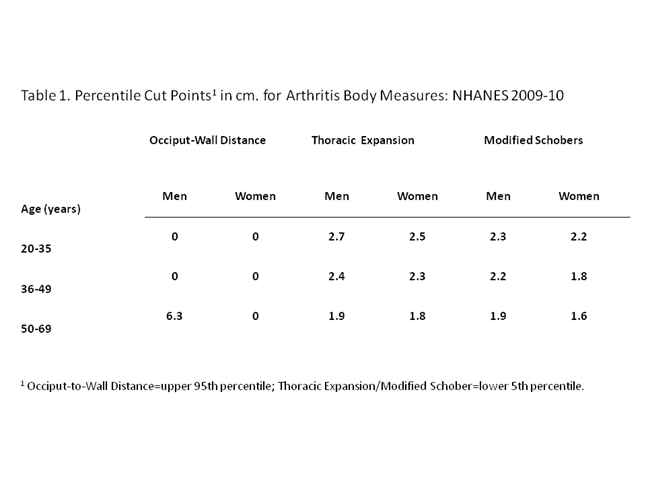Session Information
Title: Spondylarthropathies and Psoriatic Arthritis - Clinical Aspects and Treatment: Spondyloarthritis II
Session Type: Abstract Submissions (ACR)
Background/Purpose:
Spinal mobility measures are widely utilized for diagnosis and assessment of disease severity in patients with Ankylosing Spondylitis. The previously proposed threshold values for spinal metrology were determined based on distributions of these measures in convenience samples of healthy volunteers. Herein, we report population based percentile reference range values for selected spinal mobility measures in a nationally representative sample of 5103 U.S. adults ages 20-69 years examined in the 2009-10 U.S. National Health and Nutrition Examination Survey (NHANES).
Methods:
Occiput-to-Wall Distance (OWD), Thoracic Expansion (TE), Anterior Lumbar Flexion (modified Schober) were measured by trained examiners in a standardized fashion. Specifically, the difference in chest circumference expansion between complete exhalation and maximal inhalation was measured at the xiphisternum level. For the modified Schober test, the initial measurement point was a line marked at the level of the superior margin of the lateral iliac crests, then a second mark was placed 10 cm above it. NHANES sample weights and survey design variables were used.
Results:
In this nationally representative sample, 4% of subjects had an OWD of more than zero. Based on the commonly used thresholds of 2.5 or 5 cm for chest expansion, 13.6% and 62.4% of the sample had “out of range” values, respectively. Assuming that lumbar flexibility has a similar range if the measurements start at the level of lateral iliac crest rather than at the L5-S1 level, the commonly used threshold of 3.5 cm for the modified Schober was applied, resulting in 44.2% of the general population having “out of range” values.
In the present study, the upper 95th percentile of OWD measurement was zero while the 5th percentile measurements for TE and modified Schober were both 2.0. The mean (±standard error) OWD, Thoracic Expansion, and modified Schober test were 0.21 (±0.03), 4.8 (±0.06), and 3.8 (±0.03) cm, respectively. The spinal metrology parameters were significantly associated with body mass index, gender, and age. Therefore, we next excluded participants with morbid obesity (body mass index>35). This did not change the threshold values for OWD and modified Schober test but the 5th percentile for TE increased to 2.3. Furthermore, we calculated the percentiles for the spinal mobility measures stratified according to age and gender (Table1).
Conclusion:
In this nationally representative sample, we verified the threshold of zero for OWD. However, the currently utilized clinical cut points for TE and Schober Test appear to assign “abnormal” values to a large portion of the general population. Using population based percentile reference range values, we recommend new threshold values for TE and the modified Schober Test in the overall population or stratified by age and gender.
Disclosure:
S. Assassi,
None;
M. H. Weisman,
None;
Z. Chen,
None;
M. Rahbar,
None;
J. D. Reveille,
None.
« Back to 2012 ACR/ARHP Annual Meeting
ACR Meeting Abstracts - https://acrabstracts.org/abstract/new-threshold-values-for-spinal-mobility-measures-based-on-a-large-nationally-representative-sample-of-u-s-adults-ages-20-69-years/

